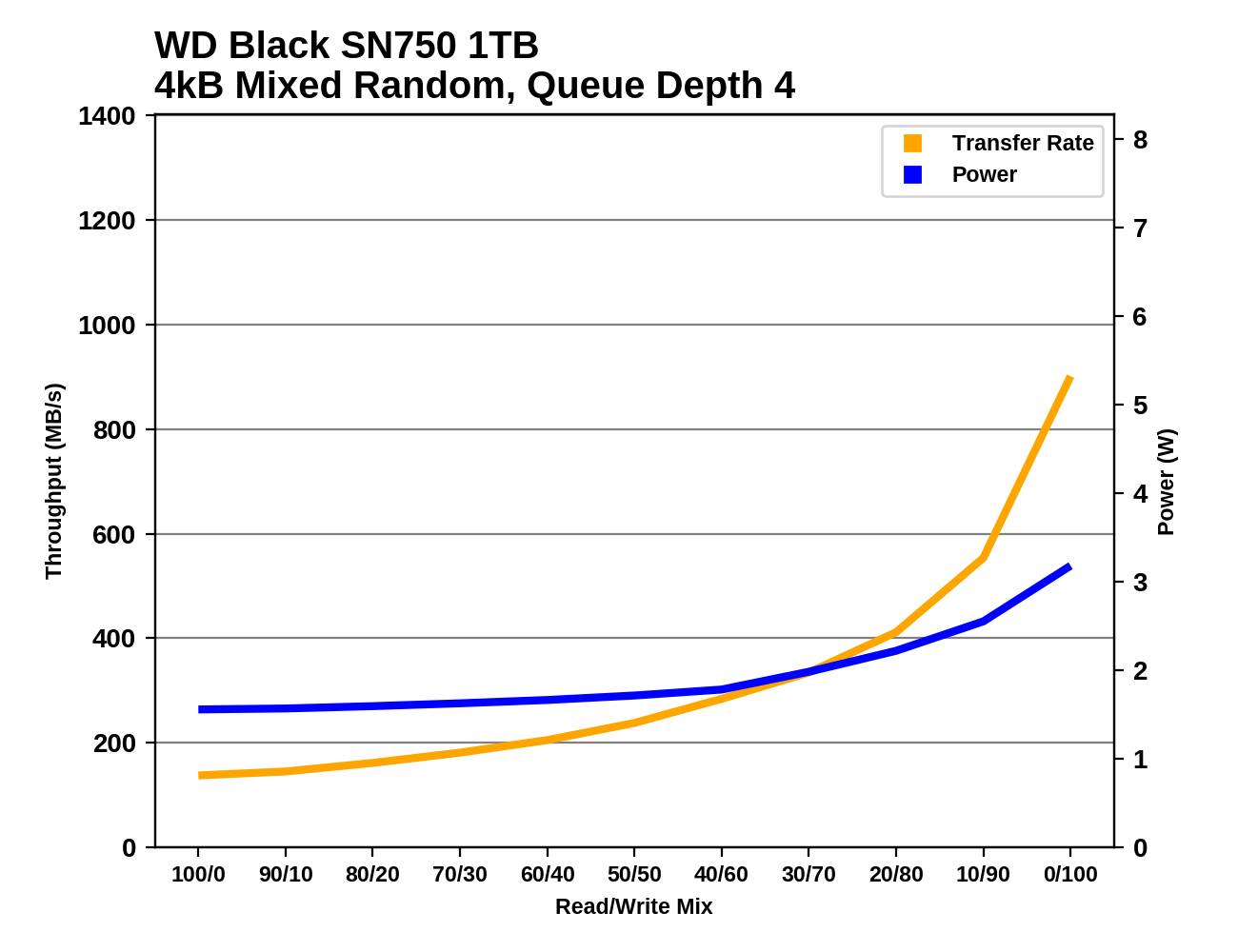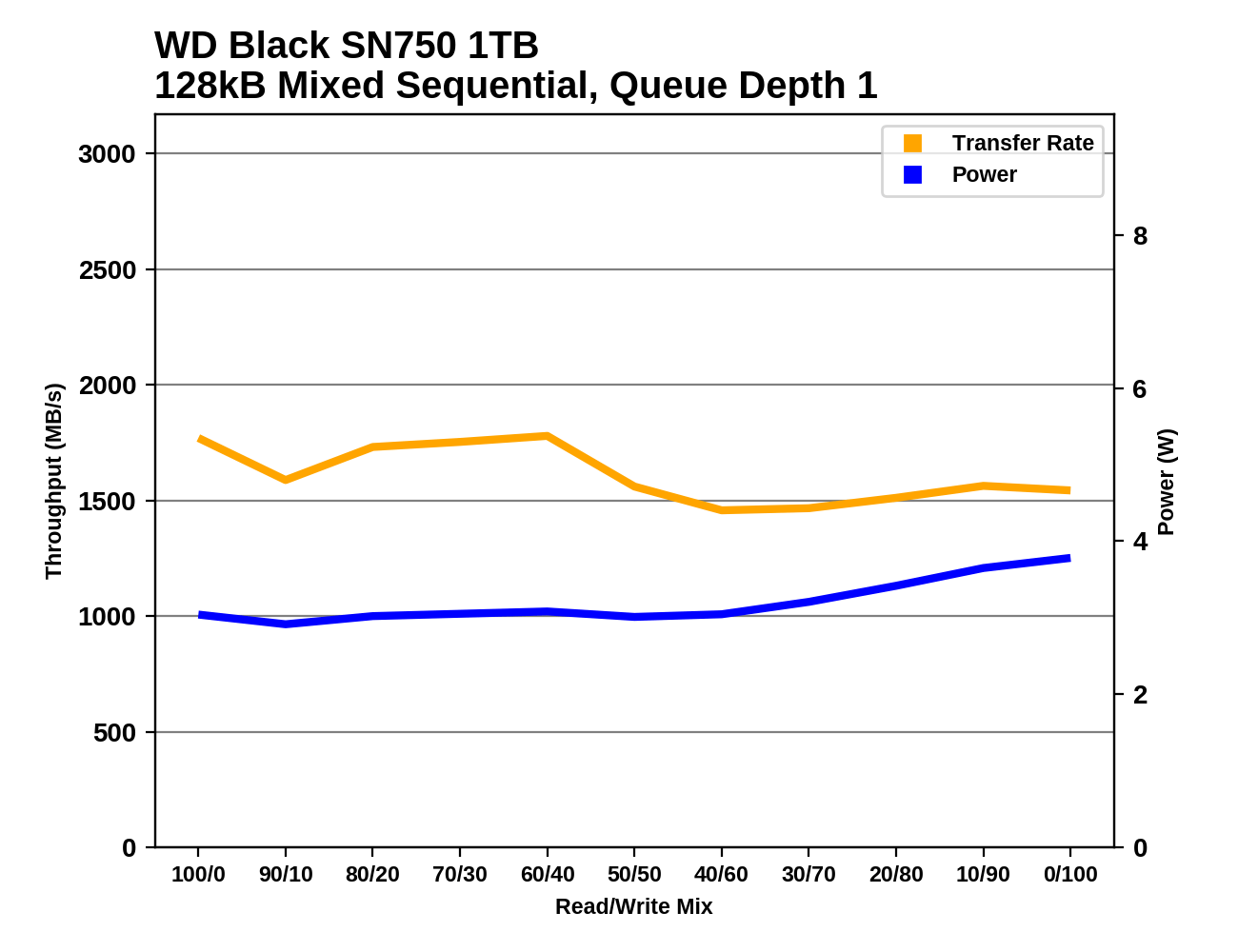The Western Digital WD Black SN750 SSD Review: Why Fix What Isn't Broken?
by Billy Tallis on January 18, 2019 8:01 AM ESTMixed Random Performance
Our test of mixed random reads and writes covers mixes varying from pure reads to pure writes at 10% increments. Each mix is tested for up to 1 minute or 32GB of data transferred. The test is conducted with a queue depth of 4, and is limited to a 64GB span of the drive. In between each mix, the drive is given idle time of up to one minute so that the overall duty cycle is 50%.

The overall mixed random IO performance of the Western Digital WD Black SN750 is about the same as the previous version, as well as the Toshiba XG6 and HP EX920. These are the second-tier drives that are a bit slower than the SM2262EN and the Samsung 970 EVO.
 |
|||||||||
| Power Efficiency in MB/s/W | Average Power in W | ||||||||
The SN750 and the Toshiba XG6 have almost exactly the same overall performance on this test, but the XG6 has 7% better performance per Watt. The second place score of the SN750 is still well above average—ignoring the outgoing WD Black, the SN750's performance per Watt is about 26% better than the next best TLC drive.
 |
|||||||||
The two flash-based drives that substantially outperform the SN750 on the mixed random IO test are faster through almost all of the test's phases, while the drives that are roughly tied with the SN750 tend to be a bit faster through the more read-heavy parts of the test and fall behind when the workload becomes very write-heavy.
Mixed Sequential Performance
Our test of mixed sequential reads and writes differs from the mixed random I/O test by performing 128kB sequential accesses rather than 4kB accesses at random locations, and the sequential test is conducted at queue depth 1. The range of mixes tested is the same, and the timing and limits on data transfers are also the same as above.

The WD Black SN750 improves upon its predecessor's performance on the mixed sequential IO test, but not quit enough to take the top spot on the performance ranking. The Samsung 970 EVO is a few percent faster overall.
 |
|||||||||
| Power Efficiency in MB/s/W | Average Power in W | ||||||||
The SN750 has a clear lead in the efficiency scores, improving upon the previous record set by last year's model that remained largely unchallenged, though the Toshiba XG6 and Corsair MP510 did come close. The average power consumption of the SN750 is slightly higher than the previous WD Black but that is more than offset by the higher average performance.
 |
|||||||||
The WD Black SN750 only barely drops below 1.5GB/s at its worst during the mixed sequential IO test, and it performs a bit better during the more read-heavy half of the test. The other drives all have worst-case performance that's slower than the SN750 by at least a few hundred MB/s, but many of those drives also have significantly better peak performance, most often at the read-heavy end of the test.










54 Comments
View All Comments
iwod - Friday, January 18, 2019 - link
Patiently waiting for PCI-E 5.0 SSD, that is 16GB/s for 4x.Ryan Smith - Friday, January 18, 2019 - link
So for what it's worth, the last time I talked to the PCI-SIG about PCIe 5, they were saying that they were expecting it to be used in conjunction with PCIe 4 rather than replacing it. The idea being that the PCIe x16 slot closest to the CPU would be a PCIe 5 slot, while everything else would be PCIe 4 due to the distances and signal integrity issues involved.If that's still the plan, then I wouldn't expect to see PCIe 5 SSDs, at least not in the M.2 form factor.
iwod - Saturday, January 19, 2019 - link
Thx. But surely Directly Attached NAND from SSD is more important? It is way more latency sensitive than GPU.I am wondering if we could get sort of like 20x Slot with 16x bandwidth. So 4x for SSD, and 8x * 2 for GPU.Most people are still using a single graphics card, I would be fine with 8x GPU PCI-E 5.0 and 4x for SSD.
Does that mean we might never see Thunderbolt 5 with PCI-E 5 signalling?
GreenReaper - Saturday, January 19, 2019 - link
Basically this is how PCIe 4 is likely to work for many existing AMD motherboards.ScouserPcgamer - Friday, January 18, 2019 - link
The Seagate Firecuda wipes the floor of read/write speeds, this is like a 1% improvement over the 2018 modelLogitechFan - Friday, January 18, 2019 - link
And then comes 970 Pro and wipes the floor with all of them and spits on their graves.LogitechFan - Friday, January 18, 2019 - link
970 Pro is not on the list?! WTF is this, an Intel commercial?!Oxford Guy - Friday, January 18, 2019 - link
What is and isn't tested is sometimes very strange here. The Nvidia GTX 960, for example, was never tested."Editor's Note: Due to personal matters we won’t have a GeForce GTX 960 review published today. But in lieu of that we wanted to go over the basics of NVIDIA’s latest Maxwell card"
Today or ever.
"Anyhow, that’s a wrap from us for now. Be sure to check back in early next week for our complete look at GeForce GTX 960, including performance, overclocking, HEVC support, and more."
Still waiting... Those promises were posted in 2015.
Oxford Guy - Friday, January 18, 2019 - link
"Conspiracy theorists" claimed the card wasn't tested because it was a turkey, making Nvidia look bad.Has Anandtech staff ever explained why the promised review never materialized?
Ryan Smith - Friday, January 18, 2019 - link
"Has Anandtech staff ever explained why the promised review never materialized?"Honestly, we're busy and despite our best efforts, sometimes bite off more than we can chew. Especially as we have imperfect vision about what products may show up on our doorsteps tomorrow.